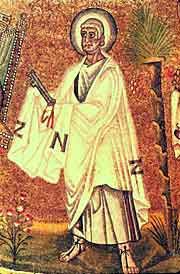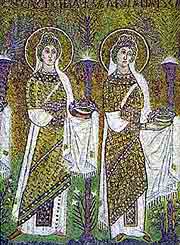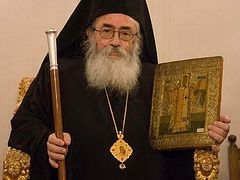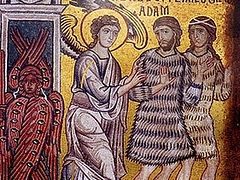 Saint Apostle Peter, baptistery mosaic, Ravenna (the 5th century)
Saint Apostle Peter, baptistery mosaic, Ravenna (the 5th century) Paradise robes look like the vestments of high priest: "Thou hast been in Eden the garden of God; every precious stone was thy covering, the sardius, topaz, and the diamond, the beryl, the onyx, and the jasper, the sapphire, the emerald, and the carbuncle, and gold" (Eze 28:13).
The connection between the temple and paradise is mentioned in the book of Joshua the son of Sirach, the Revelation of John the Theologian, as well as apocryphal books and the works of Church Fathers.
"The garden of Eden is the Holy of Holies and the abode of the Lord" (The Book of Jubilees or Small Genesis, Ch.8)."The mystery of paradise was presented by Moses who made two sanctuaries - the Holy and the Holy of Holies. The access to the external sanctuary was always free, but it was allowed to enter the internal one only once. Thus God closed from Adam the internal part of paradise, and opened the external part for him to be satisfied with the external one.
 Procession of martyr women, mosaic of St. Apolinarius of Nuovo church, Ravenna (the 6th century)
Procession of martyr women, mosaic of St. Apolinarius of Nuovo church, Ravenna (the 6th century) The tree of knowledge was for Adam the symbol of the door, the fruit - the curtain that covers the temple. The One Who planted the tree of knowledge set it in the middle to divide the highest and the lowest, the Holy and the Holy of Holies.
Adam stepped in, dared enter and was horrified. Like King Uzziah was covered with leprosy, in the same way Adam bared himself; and since he was stricken like Uzziah he retreated hastily.
In his uncleanness he wanted to enter the Holy of Holies that loves only the like; and since he dared enter the internal sanctuary, he was not left in the external one.
Let us remember Uzziah, who dared enter the sanctuary. Since he strove for High Priesthood, he lost his kingdom (2 Chr. 26:16). Adam wanted to acquire, but increased his poverty. In the sanctuary you can see a tree, in the censer - a fruit, in the leprosy - nakedness" (St. Ephraim the Syrian, On paradise, Works, vol.5., Moscow, 1995).
Speaking about the symbolism of Byzantine Divine Services, St. Symeon of Thessalonica explains: "Splendor of the temple signifies the beauty of paradise, therefore the Divine temple pictures paradise or better to say presents the paradise heavenly gifts...
In the beginning of prayers we stand outside of the temple as if outside paradise or heaven itself. And when the songs are finished and the gates open we enter the Divine temple like paradise or heaven. It means that heavenly dwellings are open to us and we got access to the Holy of Holies, we ascend to the light and approach the throne of the Lord...
Standing and singing outside the temple expresses our expulsion from paradise… The vespers can be outside the temple and signify our falling away from paradise" (St. Symeon of Thessalonica, A conversation on the sacred rites and church sacraments, Ch. 108, 123, 505 and 515). In the modern Russian orthodox services before the vespers the Royal Gates open and the priests begin with censing the altar. During singing Psalm 104 the entire temple is censed. These sacred rites symbolize the creation of the world and the blessed life of Adam and Eve in paradise. Then the Royal Gates close similar to the gates of paradise that closed after the fall of humans. Opening of the Royal Gates during singing of a Theotokion means that through incarnation of the Son of God through All-Holy Virgin Mary and His Descent to the earth the gates of paradise were opened to us.
According to the legend the Jerusalem Temple was built on the place where the Forefathers expulsed from paradise held Divine services (Louis Ginzberg, The Legends of the Jews, vol. 5). The Temple was divided into three parts - the narthex, the sanctuary and the Holy of Holies. For decoration of the Temple precious species of wood were used - cedar, fir (cypress) and algum (2 Chr. 2:8). These trees were believed to grow in the garden of God (Eze 31:8).
The golden seven-branched lamp stand was the symbol of the garden of Eden: "And he made the candlestick of pure gold: of beaten work made he the candlestick; his shaft, and his branch, his bowls, his knops, and his flowers, were of the same. And six branches going out of the sides thereof" (Exo 25:31-40; 37:17-24).
The Cherubs, palms and flowers pictured on the walls of the Temple also reminded of paradise (1 Kings 6:18, 29, 32, 35). These images were decorated with gold and precious stones: "Solomon carved upon them carvings of cherubs and palm trees and open flowers, and overlaid them with gold, and spread gold upon the cherubs, and upon the palm trees. And he carved thereon cherubs and palm trees and open flowers: and covered them with gold fitted upon the carved work" (1 Kings 6:32, 35); "And he garnished the house with precious stones for beauty" (2 Chr.3:6).
Cherubs were pictured with faces of a man, a lion, an ox and an eagle: "And on the borders that were between the ledges were lions, oxen, and cherubs: and upon the ledges there was a base above: and beneath the lions and oxen were certain additions made of thin work." (1 Kings 7:29); "Upon all the wall round about within and without were carved cherubs and palm trees between the cherubs, and each cherub had two faces. The face of a man was toward one palm tree on this side and on that side, and the face of a lion toward another palm tree on this side and on that side: the house was carved all round. From the floor to the ceiling were cherubs and palm trees carved" (Septuagint, Eze 41:17-20).
The question of cherub images "without" that is on the outside walls of the Old Testament Temple remains open for discussion. "There are no Old Testament texts, save for the little known redaction of the Greek text accepted however by editor A.Ralfs as the basic one, that testify for the external sculptural decoration of the Temple" (A.M.Visotsky, The Ezekiel Temple as the source of the external sculptural decoration of the churches in Vladimir and Suzdal (the 12th-13th centuries): sic et non, Ancient Russian art: Russia and the Byzantine countries, the 12th century, Sankt-Peterburg, 2002). Though the textological study shows that in the majority of the Old Testament redactions the Septuagint text variant about carved decoration of the temple facades is missing, the cherub images with animal faces made a part of the uniform iconographical program of external temple vessels. Images of bulls, lions and cherubs decorated the molten sea (1 Kings 7:23-25) and the bases of lavers (1 Kings 7:37). Similar images corresponded to the idea of cherubs as keepers of the holy territory of the Temple.
Faces of cherubs were embroidered on the curtain that closed the entrance into the Holy of Holies (Exo 26:31-33). The Holy of Holies was guarded by gilded sculptures of cherubs made of olive wood (1 Kings 6:23-28).
The pure gold that covered all over the Holy of Holies (1 Kings 6:20) manifested the image of the glory of God.
Ancient symbols of paradise were inherited by Christian church art. The orthodox churches are decorated with mosaics, frescos, icons, carving and floral decoration.
The orthodox iconography includes paradise palms, flowers and floral ornaments, for "the righteous shall flourish like the palm tree: he shall grow like a cedar in Lebanon. Those that be planted in the house of the LORD shall flourish in the courts of our God" (Psa 92:12-13). The Old Testament descriptions of the images of angels, palms and flowers can be compared, i.g. with the Byzantian mosaics of St. Appolinarius of Nuovo Basilica in Ravenna (the 6th century) that depict procession of martyrs, men and women, in the garden of Eden. Green meadows under the feet of the saints are dotted with lilies. Among the figures of Christian heroes palm trees can be seen that symbolize eternal life. In the period of iconoclastic heresy in Byzantium the Old Testament symbols of paradise were used instead of icons and thus according to the testimony of the contemporaries the churches "turned into gardens, flower beds and poultry-yards".
 Cherubs and palms, ancient bronze plate from South Arabia
Cherubs and palms, ancient bronze plate from South Arabia The Orthodox tradition preserved also images of cherubs with faces of a man, a line, an ox and an eagle. In the icon-painting they signify the four Evangelists - Matthew, Mark, Luke and John.
In Byzantium on the floors of the churches rivers of paradise were depicted.
On the facades of St. Dmitry Cathedral in Vladimir (the 12th century) arcature-columnar belt with palms and saints creates a symbolic border of the church as of the New Jerusalem. This iconographical motive found its original realization in the iconostasis. Significantly, St. Ephraim the Syrian compares the paradise trees with the curtain of the Old Testament tabernacle and temple. The iconostases of the Russian orthodox churches unify the images of the curtain and the garden of Eden. Their general motive of the wonderful golden garden that surrounds the icon images is interlaced with bunches of grape, leaves, fruit of the trees of paradise and flowers (Yu.N.Zvezdina, Floral ornaments in the Russian iconostasis, "Iconostasis. Origin - development - symbolism", Moscow, 2000).
In the Russian iconostases no sculptural images were allowed save for carved gilded cherubs. Obviously this exception was made under the influence of the Old Testament cherub sculptures that decorated the ark of the covenant and the Holy of Holies of the Temple.
St. Symeon of Thessalonica remarks that in the Byzantine churches there were many-branched candlesticks that had the form of paradise plants and the Burning bush (St. Symeon of Thessalonica, A conversation on the sacred rites and church sacraments, Ch. 108). The seven-branched candlestick or lampstand in the altar of a Russian church relates to the seven lamps seen by John the Theologian in the Heavenly Temple at the similar place - between the High place (the Throne of God) and the Holy (altar) table.
The gold of the background, halos, assist, precious framework of icons show the influence of the Divine light that originates from the heavenly Holy of Holies and transfiguring people and nature. Lord Jesus Christ said about Himself: "I am the light of the world" (Jn.8:12), and about His disciples also: "Ye are the light of the world" (Mt.5:14); "Then shall the righteous shine forth as the sun in the kingdom of their Father" (Mt.13:43).
John the Theologian testifies that in the spiritual Jerusalem that descends from heaven to earth (Rev.21:1-2) before the throne of God and the Lamb the Divine service is celebrated like we have in the Orthodox Church. Therefore the orthodox church is called heaven on earth and the gates of paradise. "Thy will be done in earth as it is in heaven" (Mt.6:10) - the Church prays.



